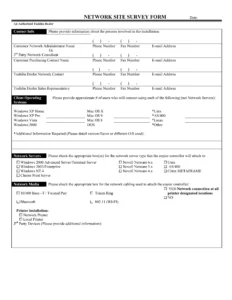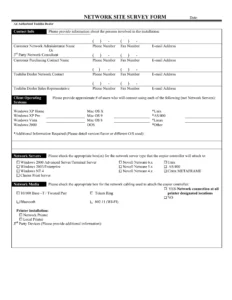Embarking on any significant network equipment installation or upgrade project without a thorough site survey is like trying to build a house without proper blueprints – you’re likely to encounter unexpected issues, delays, and potentially costly mistakes. A site survey is your eyes and ears on the ground, providing crucial information about the environment where your new network infrastructure will reside. It’s about understanding the physical space, existing connectivity, power availability, and any unique challenges that might impact your deployment.
This initial fact-finding mission is indispensable for successful project execution. It ensures that the proposed solution fits the actual site conditions, leading to smoother installations, optimal performance, and ultimately, satisfied clients. Overlooking this critical step can lead to a cascade of problems, from incompatible equipment to insufficient power, making your project unnecessarily complicated and expensive. This is precisely why having a robust network equipment site survey template is not just a convenience, but a necessity for any professional IT or networking team.
What Goes Into a Comprehensive Network Equipment Site Survey?
A truly effective site survey delves into a multitude of areas, gathering granular details that will inform every subsequent step of your network equipment deployment. It’s not just a quick glance around; it’s a systematic data collection process that leaves no stone unturned. The goal is to paint a complete picture of the site’s readiness and specific requirements for the new or upgraded network infrastructure. This involves assessing everything from the physical dimensions of a room to the specific power outlets available and the state of existing cabling.
Consider the environmental factors first. Is there adequate cooling? What are the ambient temperatures like? Is there enough physical space in the racks or on walls for the new equipment? These are fundamental questions that dictate the feasibility of your proposed solution. Then, move onto the power considerations, which are often overlooked until it’s too late. You need to know not only if there are enough outlets, but also the type of outlets, the available amperage, and if there are dedicated circuits or UPS systems in place.
Beyond the physical environment, a thorough survey evaluates the existing network infrastructure. This means understanding current network topology, identifying existing active devices, and assessing the condition and types of existing cabling. Are you dealing with Cat5e, Cat6, or fiber? Are there enough existing drops, or will new cabling runs be required? These details are vital for seamless integration and avoiding compatibility issues. Documenting these elements meticulously allows your team to design a solution that integrates flawlessly with the current setup while addressing future needs.
A well-designed network equipment site survey template guides you through these assessments systematically, ensuring consistency and preventing crucial details from being missed. It acts as a checklist and a data repository, making sure that all necessary information is captured during the initial visit.
Key Sections of Your Template
When developing or utilizing a network equipment site survey template, ensure it covers these critical areas:
- Project and Site Details: Basic information like client name, project name, survey date, site contact information, and exact site address.
- Environmental Assessment: Documentation of room dimensions, available rack space (RU units), power outlets (type, voltage, amperage), cooling (HVAC capacity, air flow), lighting, and any physical security concerns.
- Existing Infrastructure: Details on current network devices (switches, routers, firewalls), network topology diagrams, cabling types and conditions, existing IP addressing schemes, and wireless coverage if applicable.
- New Equipment Placement: Specific locations for new devices, mounting requirements (rack-mount, wall-mount), and any special considerations for accessibility or ventilation.
- Connectivity Requirements: Required port counts, uplink speeds, specific fiber or copper needs, and demarcation points.
- Security Considerations: Physical access controls, network segmentation needs, and any compliance requirements.
- Photos and Diagrams: Crucial visual documentation of the site, existing equipment, and proposed installation areas.
- Recommendations and Notes: Space for on-site observations, potential challenges, special instructions, and recommendations for the project team.
Why a Standardized Template is Your Best Friend
Implementing a standardized network equipment site survey template across all your projects brings a wealth of benefits that extend far beyond just the initial data collection. It transforms a potentially chaotic information-gathering process into a streamlined, predictable, and highly efficient operation. This consistency is invaluable, especially for teams managing multiple projects or having different technicians conducting surveys. Everyone knows exactly what information needs to be collected, how it should be presented, and where to find it.
One of the most significant advantages is the drastic reduction in the likelihood of overlooking critical details. In the complex world of network deployments, missing a single piece of information, like an obscure power requirement or a limited access point, can derail an entire project. A comprehensive template acts as a built-in checklist, prompting the surveyor to confirm every relevant aspect, thereby minimizing the risk of costly rework or unexpected delays down the line. It ensures a holistic understanding of the site.
Furthermore, a standardized template significantly improves communication and collaboration among project stakeholders. When everyone is working from the same structured document, it becomes easier for the design team to interpret the field data, for the procurement team to order the correct equipment, and for the installation team to prepare for deployment. This unified approach reduces misinterpretations and ensures that all teams are aligned with the realities of the site. It fosters a more cohesive and efficient project lifecycle from start to finish.
Beyond the immediate project benefits, a well-maintained library of completed site survey templates becomes an invaluable historical record. This documentation can be crucial for future upgrades, troubleshooting, or capacity planning. It provides a baseline reference, saving time and resources when revisiting a site years later.
- Ensures consistent data collection across all projects, regardless of who performs the survey.
- Significantly reduces the chance of overlooking critical details that could impact project success.
- Streamlines the planning, design, and deployment phases by providing readily available, organized data.
- Facilitates clearer and more efficient communication among technical teams, clients, and other stakeholders.
- Provides a reliable historical record for future upgrades, maintenance, or troubleshooting efforts.
- Helps in accurate budgeting and resource allocation by identifying potential challenges upfront.
- Boosts professionalism and client confidence by demonstrating a thorough and methodical approach.
The meticulous execution of a site survey using a well-crafted template empowers your team to make informed decisions, mitigate risks proactively, and avoid the common pitfalls associated with network equipment installations. It’s an investment in foresight that pays dividends in project success and client satisfaction. By integrating a systematic approach to site surveys, you are laying a robust foundation for reliable and high-performing network infrastructure that serves its purpose effectively.


